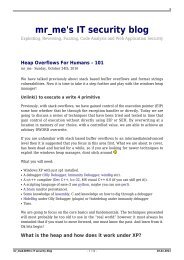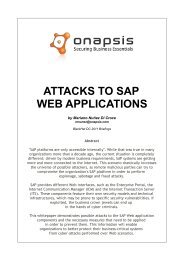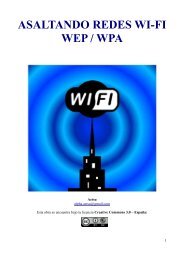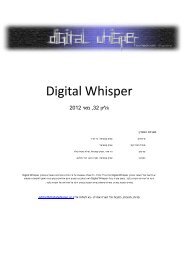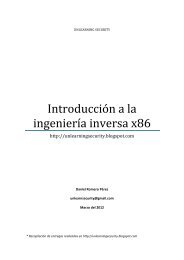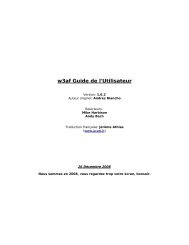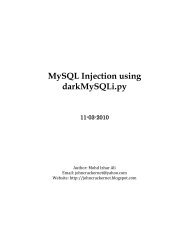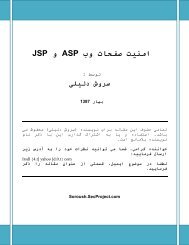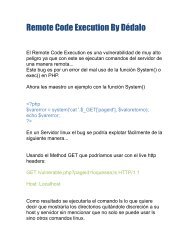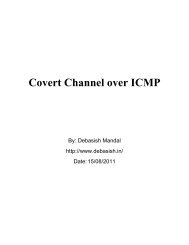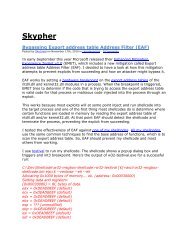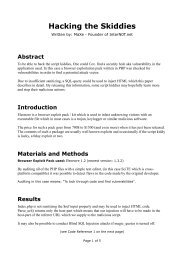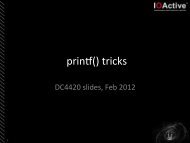Applied Binary Code Obfuscation - Intelligent Exploit
Applied Binary Code Obfuscation - Intelligent Exploit
Applied Binary Code Obfuscation - Intelligent Exploit
You also want an ePaper? Increase the reach of your titles
YUMPU automatically turns print PDFs into web optimized ePapers that Google loves.
Title:<br />
<strong>Applied</strong><br />
<strong>Binary</strong> <strong>Code</strong> <strong>Obfuscation</strong><br />
Date:<br />
January 21st 2009<br />
Website:<br />
http://www.astalavista.com<br />
Author:<br />
Nicolaou George<br />
Mail:<br />
ishtusastalavistacom<br />
Author:<br />
Glafkos Charalambous<br />
Mail:<br />
glafkosastalavistacom<br />
1
Table of Contents<br />
Introduction .............................................................................................................................. 3<br />
Tools ......................................................................................................................................... 3<br />
Instruction <strong>Obfuscation</strong>s ......................................................................................................... 3<br />
EIP (the Instruction Pointer) .................................................................................................... 3<br />
return EIP; ........................................................................................................................... 4<br />
CALL myself ....................................................................................................................... 4<br />
“MOV EAX,EIP” .................................................................................................................. 5<br />
Stack Based <strong>Obfuscation</strong> ....................................................................................................... 5<br />
1. PUSH ................................................................................................... 6<br />
2. POP ................................................................................................ 6<br />
3. CALL ............................................................................................................. 7<br />
4. RETN .............................................................................................................................. 7<br />
5. MOV ,* .................................................... 7<br />
6. JMP ............................................................................................................... 8<br />
Arithmetic and Logical <strong>Binary</strong> <strong>Obfuscation</strong> ............................................................................. 8<br />
1. ADD , ................................................................................... 9<br />
2. SUB , ................................................................................10<br />
3. ADD ,1 ............................................................................................10<br />
4. SUB ,1 ............................................................................................10<br />
5. MOV , 0 ..........................................................................................................11<br />
6. NOP ...............................................................................................................................11<br />
7. NOT ...............................................................................................12<br />
8. CMP ,0 ...........................................................................................................12<br />
9. NEG ..............................................................................................12<br />
10. MOV , ..............................................................................................13<br />
Additional <strong>Obfuscation</strong>s .........................................................................................................13<br />
SAHF/LAHF .......................................................................................................................13<br />
Polymorphisism and Self Modifying <strong>Code</strong> ..........................................................................13<br />
Example Software ...................................................................................................................14<br />
Program Analysis ..................................................................................................................14<br />
Source <strong>Code</strong> ......................................................................................................................14<br />
User Interface ....................................................................................................................16<br />
Assembled <strong>Code</strong> ................................................................................................................16<br />
General <strong>Obfuscation</strong> approach ..............................................................................................18<br />
<strong>Obfuscation</strong> Index Table ........................................................................................................21<br />
2
Introduction<br />
An obfuscated code is the one that is hard (but not impossible) to read and understand. Sometimes<br />
corporate developers, programmers and malware coders for security reasons, intentionally obfuscate<br />
their software in an attempt to delay reverse engineering or confuse antivirus engines from identifying<br />
malicious behaviors. Nowadays, obfuscation is often applied to object oriented cross-platform<br />
programming languages like Java, .NET (C#, VB), Perl, Ruby, Python and PHP. That is because their<br />
code can be easily decompiled and examined making them vulnerable to reverse engineering. On the<br />
other hand, obfuscating binary code is not as easy as encrypting object or function names as it is done in<br />
programming languages mentioned above. In this case, the code is altered by using a variety of<br />
transformations, for instance self modifying code, stack operations or even splitting the factors of simple<br />
mathematical functions. Moreover, binary obfuscation is also used to defeat automated network traffic<br />
analyzers such like Intrusion Detection and Prevention Systems. In other words, binary code obfuscation<br />
is the technique of altering the original code structure and maintaining its original functionality. In the next<br />
pages of this paper we will explore the theory and practice of binary code obfuscation as well as a<br />
number of various techniques that can be used.<br />
Tools<br />
The tools used in this paper are the following:<br />
- OllyDBG [http://www.ollydbg.de/]<br />
- WinAsm Studio [http://www.winasm.net/]<br />
Instruction <strong>Obfuscation</strong>s<br />
<strong>Obfuscation</strong> techniques aim to replace the instructions of a binary file or any other executable code with<br />
ones that have equivalent functionalities. Sometimes the size of those instructions is of no concern,<br />
since the main goal is to render the file or network traffic unreadable and undetectable. Therefore,<br />
obfuscated programs are most likely to be bigger than the original ones.<br />
We can distinguish the methods used in two main categories for the purposes of this paper:<br />
- The ones that use stack operations as a mean of obfuscation (Stack Based <strong>Obfuscation</strong>)<br />
- The ones that use logical and arithmetical and logical instructions as a mean of obfuscation<br />
(Arithmetic and Logical Based <strong>Obfuscation</strong>)<br />
EIP (the Instruction Pointer)<br />
For the purposes of some obfuscation techniques we will need to retrieve the value of EIP. However we<br />
cannot directly reference it (wouldn’t life be easier if we could do so I think not) thus we will have to<br />
find a way around. There are several ways of doing so but I will explain the most commonly used. Note<br />
that, the value of EIP is pushed into the stack each time you use the CALL instruction and we can use<br />
that to our advantage.<br />
3
eturn EIP;<br />
The simplest way to retrieve the value of EIP is to create a function that reads EIP and returns it.<br />
OFFSET+00<br />
OFFSET+05<br />
FUNCTION<br />
CALL <br />
EAX <br />
POP EAX<br />
PUSH EAX<br />
RETN<br />
At this point, EAX is equal to the value of EIP (OFFSET+05)<br />
MASM (WinAsm) <strong>Code</strong> Sample:<br />
;<strong>Code</strong> Omitted<br />
getIP PROC<br />
pop EAX<br />
push EAX<br />
retn<br />
getIP EndP<br />
;Place the value of EIP from the stack inside EAX<br />
;Push the value back to the stack so we won’t affect the program flow<br />
;<strong>Code</strong> Omitted<br />
invoke getIP ;After executing this instruction, EAX will contain the value of EIP at this point<br />
CALL myself<br />
Another way to get the value of EIP is to use a CALL function that calls itself<br />
Offset Bytes Instruction<br />
OFFSET+00<br />
OFFSET+05<br />
E8 00 00 00 00<br />
58<br />
CALL <br />
POP EAX <br />
MASM (WinAsm) <strong>Code</strong>:<br />
;<strong>Code</strong> Omitted<br />
db 0e8h ;We hard-code the actual bytes inside our code<br />
dd 00000000h<br />
pop eax ;After executing this instruction, EAX will contain the value of EIP at this point<br />
Assembled code:<br />
4
“MOV EAX,EIP”<br />
MASM (WinAsm) <strong>Code</strong> Sample 2:<br />
;<strong>Code</strong> Omitted<br />
mov eax,$ ; After executing this instruction, EAX will contain the value of EIP at this point, the offset of the next<br />
instruction therefore will be EAX+5<br />
Sample 2 assembled code:<br />
Stack Based <strong>Obfuscation</strong><br />
In this category, we will explore most techniques that use the stack as a mean of obfuscation. The stack<br />
is an abstract data structure based on the principle of FIFO (First In First Out). In our case the stack is<br />
similar to the following figure:<br />
The ESP (Stack Pointer) points to the first object inside the stack. As<br />
you can see the second item is located at ESP+4, the third at ESP+8<br />
and so on. Once a POP instruction is executed, the first item is taken<br />
out the stack, and then the stack pointer (ESP) points at the second<br />
item. Once a PUSH instruction is executed then the pushed value is<br />
added into the stack and the stack pointer (ESP) points to it.<br />
Stack based obfuscation manipulates the stack or references to it in<br />
order to succeed certain transformations of instructions.<br />
5
1. PUSH <br />
We have explained above how the PUSH instruction works. What we need to do is find a way to replace<br />
this instruction with a different one that has the same functionality.<br />
We need an instruction or a set of instructions that:<br />
- Stores the value or the value of a register in the stack<br />
- Makes ESP point to that value<br />
Since we can directly affect the ESP register and reference to the stack meaning that we are able to<br />
write data to it we could easily replace the PUSH instruction with:<br />
MOV DWORD PTR SS:[ESP-4],<br />
SUB ESP,4<br />
or<br />
SUB ESP,4<br />
MOV DWORD PTR SS:[ESP],<br />
Still we can obfuscate the PUSH instruction by storing the value to be pushed in<br />
another register or memory address<br />
MOV ,<br />
PUSH <br />
2. POP <br />
The same goes with the POP instruction. We have the stack register (ESP) currently pointing at the value<br />
we would like to retrieve from the stack and therefore we can replace POP with the following set of<br />
instructions:<br />
We store the value currently pointed by ESP into any register then balance the Stack<br />
MOV ,DWORD[ESP]<br />
ADD ESP,4<br />
Additionally, instead of directly POPing the value to the desired register (or memory address) we first<br />
POP it in a predefined memory address and copy it over to our register<br />
POP <br />
MOV ,<br />
6
3. CALL <br />
The CALL instruction is used for jumping into functions or system calls. In the processors level, the<br />
address of the next instruction is pushed into the stack for retrieval. After the function is finished<br />
executing and the RETN instruction is called, the value of the instruction pointer (EIP) changes and<br />
points to the address at the top of the stack.<br />
<strong>Code</strong>:<br />
Offset<br />
OFFSET+00<br />
OFFSET+05<br />
Instruction<br />
CALL <br />
<br />
OFFSET+05 is pushed into the stack and EIP changes to<br />
FUNCTION+XX<br />
Function x:<br />
Offset<br />
FUNCTION+00<br />
FUNCTION+XX<br />
FUNCTION+XX<br />
Instruction<br />
<br />
<br />
RETN<br />
The first value is POPed from the stack and placed into EIP<br />
We can replace this instruction with:<br />
PUSH EIP+X ; where X is the number of bytes until the next instruction (in the case above that is EIP+05)<br />
JMP ; where address is the offset of the function (in the case above that is FUNCTION+00)<br />
(Note that: the example above can be combined with the PUSH obfuscations explained in section 1)<br />
Another set of instructions we can use to replace the CALL instruction is:<br />
MOV ,<br />
CALL <br />
4. RETN<br />
The RETN instruction is used to return from a function or a system call as explained above in section 3.<br />
We can easily replace this instruction with:<br />
POP <br />
JMP <br />
(Note that: the example above can be combined with the PUSH and POP obfuscations explained in section 1 and 2)<br />
5. MOV ,*<br />
*Note that MOV , is not a valid instruction but you can still use the obfuscation set of<br />
instructions provided below to achieve it.<br />
The MOV instruction moves the value of the right side operand to the left side operand<br />
eg: LeftOPER = RightOPER<br />
This can be replaced with:<br />
7
PUSH <br />
POP <br />
; This is the right side operand<br />
; This is the left side operand<br />
(Note that: the example above can be combined with the PUSH and POP obfuscations explained in section 1 and 2.<br />
Also in order to POP to a memory address you are required to have the appropriate permissions)<br />
OR in some cases:<br />
LEA ,DWORD[]<br />
6. JMP <br />
One of the most common opcodes that are obfuscated is the JMP instruction. JMP (Jump) or any other<br />
conditional jumps (JE, JNZ, JO, JA, etc) are used for controlling program flow under certain conditions or<br />
unconditionally. Ways of obfuscating such instructions are:<br />
PUSH <br />
RETN<br />
(Note that: the example above can be combined with the PUSH and RETN obfuscations explained in section 1 and 4)<br />
CALL <br />
(Optionally at , in order to balance the stack and get rid of the return address from the stack)<br />
POP <br />
(Or)<br />
ADD ESP,4<br />
(Note that: the example above can be combined with the CALL and POP obfuscations explained in section 3 and 2)<br />
Conditional Jumps can be obfuscated by using the SAHF and LAHF instructions (See page 13)<br />
Arithmetic and Logical <strong>Binary</strong> <strong>Obfuscation</strong><br />
The Logical and Arithmetical obfuscation can be considered as less technical than the Stack Based<br />
<strong>Obfuscation</strong>. It involves the use of simple mathematical and logical functions like ADD, SUB, AND, NOT,<br />
NEG, OR, XOR, TEST, SHL, LEA, etc.<br />
Every mathematical function f() can be written in many ways. It can be simplified or expanded in any<br />
way you like. For example:<br />
f(y) = 5 * 4 + 10<br />
Can be written as:<br />
f(y) = (2+3) * (2+2) + 9 + 1<br />
Or:<br />
i,j= 0;<br />
inc(y) = x+1<br />
f(y) = inc(inc(inc(inc(inc(i))))) * inc(inc(inc(inc(inc(j))))) + inc(j+i)<br />
8
Additionally, a Boolean expression (x OR y):<br />
x<br />
y v x 0 1<br />
y<br />
0 0 1<br />
1 1 1<br />
Can be expressed as NOT(NOT(x) AND NOT(y)):<br />
x<br />
¬(¬y ^ ¬x) 0 1<br />
y<br />
0 0 1<br />
1 1 1<br />
1. ADD , <br />
The ADD instruction is simple it adds the second operant to the first. Cases:<br />
- You have a register that holds a value X (ADD EAX,)<br />
- You have a register that points to a memory offset that holds a value X (ADD [EAX],)<br />
- You have a direct memory offset that holds a value X (ADD [],<br />
In elementary math that is presented as:<br />
y = y + x<br />
This is equal to:<br />
y = y - (-x)<br />
In low level programming that can be written as:<br />
SUB y,-x<br />
This can be replaced with:<br />
SUB , -<br />
Or by using LEA:<br />
LEA , DWORD [+]<br />
(Note that: you cannot directly reference to a memory offset using the LEA instruction. Although, if needed you could<br />
load the memory value to a register, apply this instruction and finally put it back. Note that DWORD could also be<br />
BYTE or WORD)<br />
9
2. SUB , <br />
Similarly, the ADD instruction, the same cases apply. SUB subtracts the second operant from the first.<br />
Therefore functions like:<br />
y = y – x<br />
Can be expressed as:<br />
y = y + (-x)<br />
This can be replaced with:<br />
ADD , -<br />
Using LEA:<br />
LEA , DWORD[-]<br />
(Note that: you cannot directly reference to a memory offset using the LEA instruction. Although, if needed you could<br />
load the memory value to a register, apply this instruction and write it back)<br />
3. ADD ,1<br />
Adding the value one to a register or a memory location can be also expressed by NEG(NOT(value)).<br />
Note that this affects CF and AF flags (Carry Flag, Auxiliary Flag)<br />
This can be replaced with:<br />
NOT <br />
NEG <br />
Using LEA:<br />
LEA , DWORD [+1]<br />
4. SUB ,1<br />
Subtracting from a register or a value in memory the value 1<br />
This can be replaced with:<br />
NEG <br />
NOT <br />
Using LEA:<br />
LEA , DWORD [-1]<br />
10
5. MOV , 0<br />
Changing the value of a register to zero (0). Note that this could be combined with section 5 of Stack<br />
Based obfuscations.<br />
This can be replaced with:<br />
AND ,0<br />
Or:<br />
SHL , 30<br />
SHL , 30<br />
(Note that: SHL can affect Z,S and O flags)<br />
Or:<br />
XOR ,<br />
Or:<br />
SUB ,<br />
Or:<br />
LEA , DWORD[0]<br />
Additionally, changing the value of a(n) 16bit or 8bit register could also be achieved by:<br />
16bit (for AX):<br />
AND , FFFF0000<br />
8bit (for AL):<br />
AND , FFFFFF00<br />
6. NOP<br />
No operation, no impact on the CPU and memory. It only changes the EIP. NOP is equivalent to the<br />
instruction XCHG (E)AX,(E)AX.<br />
This can be replaced with:<br />
AND ,FFFFFFFF (-1)<br />
(3 byte with register, 7 byte with memory)<br />
SHL , 0<br />
(3 byte)<br />
SHR , 0<br />
(3 byte)<br />
MOV , <br />
(2 byte)<br />
XOR , 0<br />
(3 byte with register, 7 byte with memory (need write permissions), also affects P, A, Z flags)<br />
ADD , 0<br />
(3 byte with register, 7 byte with memory)<br />
11
SUB
10. MOV ,<br />
This can be replaced with:<br />
LEA ,[]<br />
Additional <strong>Obfuscation</strong>s<br />
SAHF/LAHF<br />
These instructions are responsible for loading and storing the CPU flags (EFLAGS) SF, ZF, PF, AF, and CF<br />
to the AH register and storing them back.<br />
These instructions execute as described above in compatibility mode and legacy mode.<br />
They are valid in 64-bit mode only if CPUID.80000001H:ECX.LAHF-SAHF[bit 0] = 1.<br />
LAHF<br />
Loads flags to the corresponding bits in AH register as shown below:<br />
SF ZF ** AF ** PF ** CF<br />
0 0 0 0 0 0 1 0<br />
** Reserved bits<br />
SAHF<br />
Stores the contents of AH register to flags.<br />
An example code for using SAHF and LAHF instructions<br />
XOR EAX, EAX<br />
XOR EBX, EBX<br />
MOV AL, 1 ; Set EAX = 00000001 and EBX = 00000000<br />
CMP EAX, EBX ; Compare EAX with EBX => PF = 0 ZF = 0<br />
LAHF ; Store Flags in AH, EAX = 00000201<br />
TEST EBX, EBX ; PF = 1 ZF = 1<br />
SAHF ; Load Flags from AH => PF = 0 ZF = 0<br />
JNZ ; Jump if Not Zero (if ZF is equal to 0)<br />
Polymorphism and Self Modifying <strong>Code</strong><br />
Polymorphisism techniques can be used to encrypt/decrypt code. You can either use a stub to decrypt<br />
the whole code and execute it or decrypt sections of the code needed for execution and then discard<br />
them (a type of Self Modifying <strong>Code</strong>). Polymorphisism and Self Modifying <strong>Code</strong> do not fall under the<br />
scope of this paper.<br />
13
Example Software<br />
Program Name: getWAN<br />
Md5sum: 1b73530132dd7f66fea5f29beb7a6c60<br />
Compiler: MASM (WinAsm)<br />
Program Analysis<br />
Source <strong>Code</strong><br />
getWAN.asm<br />
.486<br />
.model flat, stdcall<br />
option casemap :none<br />
include<br />
.code<br />
start:<br />
getWAN.inc<br />
invoke GetModuleHandle, NULL<br />
mov hInstance, eax<br />
invoke DialogBoxParam, hInstance, 101, 0, ADDR DlgProc, 0<br />
invoke ExitProcess, eax<br />
DlgProc proc hWin :DWORD,<br />
uMsg :DWORD,<br />
wParam :DWORD,<br />
lParam :DWORD<br />
.if uMsg == WM_COMMAND<br />
.if wParam == GET<br />
invoke GetWANIP,addr Weburl<br />
invoke SetDlgItemText,hWin,RESULT,addr html<br />
.elseif wParam == EXIT<br />
invoke EndDialog,hWin,0<br />
.endif<br />
.elseif uMsg == WM_CLOSE<br />
invoke EndDialog,hWin,0<br />
.endif<br />
xor eax,eax<br />
ret<br />
DlgProc endp<br />
GetWANIP PROC url:DWORD<br />
local hInternet:DWORD<br />
local hURL:DWORD<br />
local hFile:DWORD<br />
local len:DWORD<br />
invoke InternetOpen,addr ipszAgent,INTERNET_OPEN_TYPE_PRECONFIG,0,0,0<br />
mov hInternet,eax<br />
invoke InternetOpenUrl,hInternet,url,0,0,0,0<br />
14
mov hURL,eax<br />
invoke InternetReadFile,hURL,addr html,sizeof html,addr len<br />
invoke InternetCloseHandle,hURL<br />
.if eax==0<br />
invoke InternetCloseHandle,hInternet<br />
Ret<br />
.endif<br />
Ret<br />
GetWANIP EndP<br />
end start<br />
getWAN.inc<br />
include windows.inc<br />
include user32.inc<br />
include kernel32.inc<br />
include wsock32.inc<br />
include wininet.inc<br />
;-------------------------------------------------------------------------------------------------------------------------<br />
includelib user32.lib<br />
includelib kernel32.lib<br />
includelib wsock32.lib<br />
includelib wininet.lib<br />
;-------------------------------------------------------------------------------------------------------------------------<br />
DlgProc PROTO :DWORD,:DWORD,:DWORD,:DWORD<br />
GetWANIP PROTO :DWORD<br />
;-------------------------------------------------------------------------------------------------------------------------<br />
GET equ 1001<br />
EXIT equ 1002<br />
RESULT equ 1003<br />
;-------------------------------------------------------------------------------------------------------------------------<br />
.data<br />
Weburl db "http://www.whatismyip.com/automation/n09230945.asp",0<br />
ipszAgent db "Mozilla/6.9",0<br />
.data<br />
hInstance dd <br />
buffer db 256 dup()<br />
html db 256 dup()<br />
;-------------------------------------------------------------------------------------------------------------------------<br />
15
getWAN.rc<br />
;This Resource Script was generated by WinAsm Studio.<br />
#define GET 1001<br />
#define EXIT 1002<br />
#define RESULT 1003<br />
101 DIALOGEX 0,0,109,35<br />
CAPTION "getWAN"<br />
FONT<br />
8,"Tahoma"<br />
STYLE 0x80c80880<br />
EXSTYLE 0x00000000<br />
BEGIN<br />
CONTROL "Get IP",GET,"Button",0x10000001,3,18,50,14,0x00000000<br />
CONTROL "Exit",EXIT,"Button",0x10000000,56,18,50,14,0x00000000<br />
CONTROL "",RESULT,"Edit",0x10000080,3,3,101,12,0x00000200<br />
END<br />
User Interface<br />
RESULT<br />
EXIT<br />
GET<br />
Assembled <strong>Code</strong><br />
00401000 >/$ 6A 00 PUSH 0 ; /pModule = NULL<br />
00401002 |. E8 FB000000 CALL ; \GetModuleHandleA<br />
00401007 |. A3 40304000 MOV DWORD PTR DS:[403040],EAX<br />
0040100C |. 6A 00 PUSH 0 ; /lParam = NULL<br />
0040100E |. 68 28104000 PUSH getWAN.00401028 ; |DlgProc = getWAN.00401028<br />
00401013 |. 6A 00 PUSH 0 ; |hOwner = NULL<br />
00401015 |. 6A 65 PUSH 65 ; |pTemplate = 65<br />
00401017 |. FF35 40304000 PUSH DWORD PTR DS:[403040] ; |hInst = NULL<br />
0040101D |. E8 C8000000 CALL ; \DialogBoxParamA<br />
00401022 |. 50 PUSH EAX ; /Exit<strong>Code</strong><br />
00401023 \. E8 D4000000 CALL ; \ExitProcess<br />
00401028 /. 55 PUSH EBP<br />
00401029 |. 8BEC MOV EBP,ESP<br />
0040102B |. 817D 0C 11010> CMP DWORD PTR SS:[EBP+C],111<br />
00401032 |. 75 3C JNZ SHORT getWAN.00401070<br />
00401034 |. 817D 10 E9030> CMP DWORD PTR SS:[EBP+10],3E9<br />
0040103B |. 75 1E JNZ SHORT getWAN.0040105B<br />
0040103D |. 68 00304000 PUSH getWAN.00403000 ; /Arg1 = 00403000 ASCII<br />
"http://www.whatismyip.com/<br />
automation/n09230945.asp"<br />
16
00401042 |. E8 3F000000 CALL getWAN.00401086 ; \getWAN.00401086<br />
00401047 |. 68 44314000 PUSH getWAN.00403144 ; /Text = ""<br />
0040104C |. 68 EB030000 PUSH 3EB ; |ControlID = 3EB (1003.)<br />
00401051 |. FF75 08 PUSH DWORD PTR SS:[EBP+8] ; |hWnd<br />
00401054 |. E8 9D000000 CALL ; \SetDlgItemTextA<br />
00401059 |. EB 25 JMP SHORT getWAN.00401080<br />
0040105B |> 817D 10 EA030> CMP DWORD PTR SS:[EBP+10],3EA<br />
00401062 |. 75 1C JNZ SHORT getWAN.00401080<br />
00401064 |. 6A 00 PUSH 0 ; /Result = 0<br />
00401066 |. FF75 08 PUSH DWORD PTR SS:[EBP+8] ; |hWnd<br />
00401069 |. E8 82000000 CALL ; \EndDialog<br />
0040106E |. EB 10 JMP SHORT getWAN.00401080<br />
00401070 |> 837D 0C 10 CMP DWORD PTR SS:[EBP+C],10<br />
00401074 |. 75 0A JNZ SHORT getWAN.00401080<br />
00401076 |. 6A 00 PUSH 0 ; /Result = 0<br />
00401078 |. FF75 08 PUSH DWORD PTR SS:[EBP+8] ; |hWnd<br />
0040107B |. E8 70000000 CALL ; \EndDialog<br />
00401080 |> 33C0 XOR EAX,EAX<br />
00401082 |. C9 LEAVE<br />
00401083 \. C2 1000 RETN 10<br />
00401086 /$ 55 PUSH EBP<br />
00401087 |. 8BEC MOV EBP,ESP<br />
00401089 |. 83C4 F0 ADD ESP,-10<br />
0040108C |. 6A 00 PUSH 0<br />
0040108E |. 6A 00 PUSH 0<br />
00401090 |. 6A 00 PUSH 0<br />
00401092 |. 6A 00 PUSH 0<br />
00401094 |. 68 33304000 PUSH getWAN.00403033 ; ASCII "Mozilla/6.9"<br />
00401099 |. E8 70000000 CALL <br />
0040109E |. 8945 FC MOV DWORD PTR SS:[EBP-4],EAX<br />
004010A1 |. 6A 00 PUSH 0<br />
004010A3 |. 6A 00 PUSH 0<br />
004010A5 |. 6A 00 PUSH 0<br />
004010A7 |. 6A 00 PUSH 0<br />
004010A9 |. FF75 08 PUSH DWORD PTR SS:[EBP+8]<br />
004010AC |. FF75 FC PUSH DWORD PTR SS:[EBP-4]<br />
004010AF |. E8 60000000 CALL <br />
004010B4 |. 8945 F8 MOV DWORD PTR SS:[EBP-8],EAX<br />
004010B7 |. 8D45 F0 LEA EAX,DWORD PTR SS:[EBP-10]<br />
004010BA |. 50 PUSH EAX<br />
004010BB |. 68 00010000 PUSH 100<br />
004010C0 |. 68 44314000 PUSH getWAN.00403144<br />
004010C5 |. FF75 F8 PUSH DWORD PTR SS:[EBP-8]<br />
004010C8 |. E8 4D000000 CALL <br />
004010CD |. FF75 F8 PUSH DWORD PTR SS:[EBP-8]<br />
004010D0 |. E8 33000000 CALL <br />
004010D5 |. 0BC0 OR EAX,EAX<br />
004010D7 |. 75 0C JNZ SHORT getWAN.004010E5<br />
004010D9 |. FF75 FC PUSH DWORD PTR SS:[EBP-4]<br />
004010DC |. E8 27000000 CALL <br />
004010E1 |. C9 LEAVE<br />
004010E2 |. C2 0400 RETN 4<br />
17
004010E5 |> C9 LEAVE<br />
004010E6 \. C2 0400 RETN 4<br />
004010E9 CC INT3<br />
004010EA $- FF25 14204000 JMP DWORD PTR DS:[; user32.DialogBoxParamA<br />
004010F0 $- FF25 10204000 JMP DWORD PTR DS:[] ; user32.EndDialog<br />
004010F6 $- FF25 0C204000 JMP DWORD PTR DS:[; user32.SetDlgItemTextA<br />
004010FC .- FF25 04204000 JMP DWORD PTR DS:[; kernel32.ExitProcess<br />
00401102 $- FF25 00204000 JMP DWORD PTR DS:[; kernel32.GetModuleHandleA<br />
00401108 $- FF25 28204000 JMP DWORD PTR DS:[; wininet.InternetCloseHandle<br />
0040110E $- FF25 1C204000 JMP DWORD PTR DS:[; wininet.InternetOpenA<br />
00401114 $- FF25 20204000 JMP DWORD PTR DS:[; wininet.InternetOpenUrlA<br />
0040111A $- FF25 24204000 JMP DWORD PTR DS:[; wininet.InternetReadFile<br />
General <strong>Obfuscation</strong> approach<br />
The following assembly code is an example of how you could obfuscate the code.<br />
00401000 > C74424 FC 000> MOV DWORD PTR SS:[ESP-4],0<br />
00401008 83EC 04 SUB ESP,4<br />
0040100B E8 00000000 CALL getWAN_o.00401010<br />
00401010 $ 8F05 40304000 POP DWORD PTR DS:[403040]<br />
00401016 . 832D 40304000> SUB DWORD PTR DS:[403040],-18<br />
0040101D . FF35 40304000 PUSH DWORD PTR DS:[403040]<br />
00401023 . E9 DA000000 JMP <br />
00401028 . A3 40304000 MOV DWORD PTR DS:[403040],EAX<br />
0040102D . C74424 FC 000> MOV DWORD PTR SS:[ESP-4],0<br />
00401035 . 83EC 04 SUB ESP,4<br />
00401038 . 68 79104000 PUSH getWAN_o.00401079<br />
0040103D . 6A 00 PUSH 0<br />
0040103F . C74424 FC 650> MOV DWORD PTR SS:[ESP-4],65<br />
00401047 . 83EC 04 SUB ESP,4<br />
0040104A . FF35 40304000 PUSH DWORD PTR DS:[403040]<br />
00401050 . E8 00000000 CALL getWAN_o.00401055<br />
00401055 $ 8F05 50304000 POP DWORD PTR DS:[403050]<br />
0040105B . 832D 50304000> SUB DWORD PTR DS:[403050],-18<br />
00401062 . FF35 50304000 PUSH DWORD PTR DS:[403050]<br />
00401068 . E9 7D000000 JMP <br />
0040106D . 894424 FC MOV DWORD PTR SS:[ESP-4],EAX<br />
00401071 . 83EC 04 SUB ESP,4<br />
00401074 . E9 83000000 JMP <br />
00401079 . 55 PUSH EBP<br />
0040107A . 54<br />
PUSH ESP<br />
0040107B . 5D<br />
POP EBP<br />
0040107C . 817D 0C 11010> CMP DWORD PTR SS:[EBP+C],111<br />
00401083 . 75 51 JNZ SHORT getWAN_o.004010D6<br />
00401085 . 817D 10 E9030> CMP DWORD PTR SS:[EBP+10],3E9<br />
0040108C . 75 2C<br />
JNZ SHORT getWAN_o.004010BA<br />
0040108E . 68 00304000 PUSH getWAN_o.00403000 ; ASCII "http://www.whatismyi....”<br />
00401093 . B8 37114000 MOV EAX,getWAN_o.00401137<br />
00401098 . FFD0 CALL EAX<br />
0040109A . 68 44314000 PUSH getWAN_o.00403144<br />
18
0040109F . C74424 FC EB0> MOV DWORD PTR SS:[ESP-4],3EB<br />
004010A7 . 83EC 04<br />
SUB ESP,4<br />
004010AA . FF75 08<br />
PUSH DWORD PTR SS:[EBP+8]<br />
004010AD . E8 00000000 CALL getWAN_o.004010B2<br />
004010B2 $ 830424 06 ADD DWORD PTR SS:[ESP],6<br />
004010B6 . EB 3E<br />
JMP SHORT <br />
004010B8 . EB 6C<br />
JMP SHORT getWAN_o.00401126<br />
004010BA > B8 EA030000 MOV EAX,3EA<br />
004010BF . 3945 10<br />
CMP DWORD PTR SS:[EBP+10],EAX<br />
004010C2 . 75 62<br />
JNZ SHORT getWAN_o.00401126<br />
004010C4 . 6A 00 PUSH 0<br />
004010C6 . FF75 08<br />
PUSH DWORD PTR SS:[EBP+8]<br />
004010C9 > E8 00000000 CALL getWAN_o.004010CE<br />
004010CE $ 830424 07 ADD DWORD PTR SS:[ESP],7<br />
004010D2 . EB 1C<br />
JMP SHORT <br />
004010D4 . EB 50<br />
JMP SHORT getWAN_o.00401126<br />
004010D6 > 05 26FCFFFF ADD EAX,-3DA<br />
004010DB . 837D 0C 10 CMP DWORD PTR SS:[EBP+C],10<br />
004010DF . 75 45<br />
JNZ SHORT getWAN_o.00401126<br />
004010E1 . 6A 00 PUSH 0<br />
004010E3 . EB 3C<br />
JMP SHORT getWAN_o.00401121<br />
004010E5 CC INT3<br />
004010E6 CC INT3<br />
004010E7 CC INT3<br />
004010E8 CC INT3<br />
004010E9 CC INT3<br />
004010EA >- FF25 14204000 JMP DWORD PTR DS:[; user32.DialogBoxParamA<br />
004010F0 >- FF25 10204000 JMP DWORD PTR DS:[] ; user32.EndDialog<br />
004010F6 >- FF25 0C204000 JMP DWORD PTR DS:[; user32.SetDlgItemTextA<br />
004010FC >- FF25 04204000 JMP DWORD PTR DS:[; kernel32.ExitProcess<br />
00401102 >- FF25 00204000 JMP DWORD PTR DS:[; kernel32.GetModuleHandleA<br />
00401108 $- FF25 28204000 JMP DWORD PTR DS:[; wininet.InternetCloseHandle<br />
0040110E $- FF25 1C204000 JMP DWORD PTR DS:[; wininet.InternetOpenA<br />
00401114 $- FF25 20204000 JMP DWORD PTR DS:[; wininet.InternetOpenUrlA<br />
0040111A $- FF25 24204000 JMP DWORD PTR DS:[; wininet.InternetReadFile<br />
00401120 00 DB 00<br />
00401121 > FF75 08 PUSH DWORD PTR SS:[EBP+8]<br />
00401124 .^ EB A3 JMP SHORT getWAN_o.004010C9<br />
00401126 > 6A 00 PUSH 0<br />
00401128 660F1F84000000> NOP<br />
00401131 58 POP EAX<br />
00401132 C9 LEAVE<br />
00401133 . C2 1000 RETN 10<br />
00401136 00 DB 00<br />
00401137 /. 55 PUSH EBP<br />
00401138 |. 8BEC MOV EBP,ESP<br />
0040113A |. 83C4 F0<br />
ADD ESP,-10<br />
0040113D |. 6A 00 PUSH 0<br />
0040113F |. 6A 00 PUSH 0<br />
00401141 |. 6A 00 PUSH 0<br />
00401143 |. 6A 00 PUSH 0<br />
00401145 |. 68 33304000 PUSH getWAN_o.00403033 ; ASCII "Mozilla/6.9"<br />
19
0040114A |. E8 BFFFFFFF CALL <br />
0040114F |. 8945 FC<br />
MOV DWORD PTR SS:[EBP-4],EAX<br />
00401152 |. 6A 00 PUSH 0<br />
00401154 |. 6A 00 PUSH 0<br />
00401156 |. 6A 00 PUSH 0<br />
00401158 |. 6A 00 PUSH 0<br />
0040115A |. FF75 08<br />
PUSH DWORD PTR SS:[EBP+8]<br />
0040115D |. FF75 FC<br />
PUSH DWORD PTR SS:[EBP-4]<br />
00401160 |. E8 AFFFFFFF CALL <br />
00401165 |. 8945 F8 MOV DWORD PTR SS:[EBP-8],EAX<br />
00401168 |. 8D45 F0 LEA EAX,DWORD PTR SS:[EBP-10]<br />
0040116B |. 50<br />
PUSH EAX<br />
0040116C |. 68 00010000 PUSH 100<br />
00401171 |. 68 44314000 PUSH getWAN_o.00403144<br />
00401176 |. FF75 F8 PUSH DWORD PTR SS:[EBP-8]<br />
00401179 |. E8 9CFFFFFF CALL <br />
0040117E |. FF75 F8<br />
PUSH DWORD PTR SS:[EBP-8]<br />
00401181 |. E8 82FFFFFF CALL <br />
00401186 |. 0BC0 OR EAX,EAX<br />
00401188 |. 75 0C JNZ SHORT getWAN_o.00401196<br />
0040118A |. FF75 FC<br />
PUSH DWORD PTR SS:[EBP-4]<br />
0040118D |. E8 76FFFFFF CALL <br />
00401192 |. C9 LEAVE<br />
00401193 |. C2 0400 RETN 4<br />
00401196 |> C9 LEAVE<br />
00401197 \. C2 0400 RETN 4<br />
20
<strong>Obfuscation</strong> Index Table<br />
Instruction<br />
PUSH <br />
POP <br />
CALL <br />
JMP <br />
RETN<br />
SUB ,<br />
ADD ,<br />
PUSH <br />
POP <br />
ADD ,1<br />
SUB ,1<br />
***MOV ,0<br />
Equal Instructions<br />
MOV DWORD PTR SS:[ESP-4],<br />
SUB ESP,4<br />
OR<br />
MOV ,<br />
PUSH <br />
MOV , DWORD [ESP]<br />
ADD ESP,4<br />
OR<br />
POP <br />
MOV ,<br />
PUSH EIP + bytes to next instruction<br />
JMP <br />
OR<br />
MOV ,<br />
CALL <br />
PUSH <br />
RETN<br />
OR<br />
CALL <br />
At address:<br />
POP or ADD ESP,4<br />
POP EAX<br />
JMP EAX<br />
ADD , -<br />
OR<br />
LEA , DWORD [-]<br />
SUB ,-<br />
OR<br />
LEA , DWORD [+]<br />
MOV ,<br />
NOT <br />
NEG <br />
(affects C and A flags)<br />
LEA ,DWORD[+1]<br />
NEG <br />
NOT <br />
OR<br />
LEA ,DWORD[-1]<br />
AND ,0<br />
OR<br />
SHL ,30<br />
SHL ,30<br />
21
(note that this affects the Z,S and O flags)<br />
OR<br />
PUSH 0<br />
POP <br />
OR<br />
XOR ,<br />
OR<br />
SUB ,<br />
OR<br />
LEA , DWORD [0]<br />
MOV ,0<br />
AND ,FFFF0000<br />
AND , 0000<br />
NOP AND ,FFFFFFFF (-1)<br />
OR<br />
SHL ,0 (logical shift left)<br />
OR<br />
SHR ,0 (logical shift right)<br />
OR<br />
MOV ,<br />
OR<br />
XOR ,0<br />
OR<br />
ADD ,0<br />
OR<br />
SUB ,0<br />
OR<br />
OR ,0<br />
OR<br />
PUSH <br />
POP <br />
OR<br />
XCHG <br />
OR<br />
FNOP<br />
OR<br />
LEA , []<br />
OR<br />
FNOP<br />
NOT <br />
XOR ,-1<br />
OR<br />
NEG <br />
SUB ,1<br />
MOV , PUSH <br />
POP <br />
OR<br />
22
CMP ,0<br />
**MOV ,<br />
MOV ,<br />
MOV ,* (NO such<br />
instruction)<br />
NEG <br />
MOV DWORD [],<br />
MOV , DWORD []<br />
OR<br />
LEA , DWORD []<br />
OR<br />
MOV ,<br />
MOV ,<br />
OR ,<br />
OR<br />
AND ,<br />
OR<br />
TEST ,<br />
LEA ,[]<br />
OR<br />
PUSH <br />
POP <br />
PUSH <br />
POP <br />
PUSH <br />
POP <br />
NOT <br />
ADD ,1<br />
Greetings<br />
I would like to say thank you to the people that helped me writing this paper. Special thanks fly out to<br />
Maria-Lena Demetriou for correcting and pointing out some grammatical errors :)<br />
23



